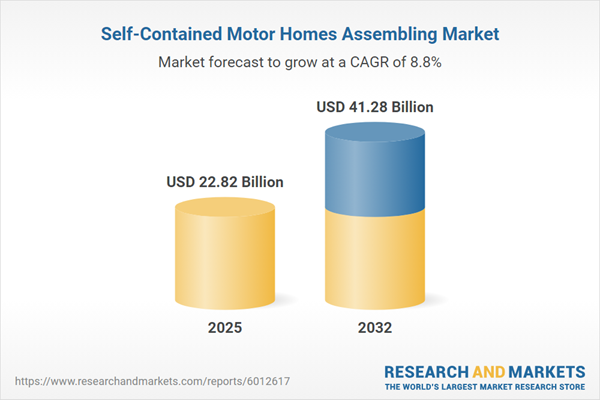Speak directly to the analyst to clarify any post sales queries you may have.
The Self-Contained Motor Homes Assembling Market is undergoing rapid evolution, driven by technology integration, shifting consumer expectations, and new global trade conditions. Senior decision-makers now face a complex landscape where innovation, adaptability, and strategic sourcing are key for maintaining competitive edge.
Market Snapshot: Self-Contained Motor Homes Assembling Market
The Self-Contained Motor Homes Assembling Market grew from USD 20.96 billion in 2024 to USD 22.82 billion in 2025. It is expected to continue expanding at a CAGR of 8.83%, reaching USD 41.28 billion by 2032. Expansion is fueled by ongoing consumer demand for mobile, flexible living solutions, as well as strong innovation in powertrain and interior technologies. The market’s long-term trajectory reflects robust appetite for leisure travel, evolving remote work patterns, and surging interest in connected mobility solutions.
Scope & Segmentation of the Self-Contained Motor Homes Assembling Market
- Product Type: Class A (diesel and gasoline engine), Class B (gasoline engine), Class C (diesel and gasoline engine)
- Distribution Channel: Dealership (exclusive dealer, independent dealer), Online (marketplace platforms, OEM websites), Rental (long term, short term)
- Fuel Type: Diesel (Class A, Class C), Electric Hybrid (commercial models, prototype), Gasoline (Class A, Class B, Class C)
- End User: Commercial (corporate travel, rental fleets), Individual (owner user, rental customer)
- Regional Coverage: Americas (North America: United States, Canada, Mexico; Latin America: Brazil, Argentina, Chile, Colombia, Peru), Europe, Middle East & Africa (Europe: United Kingdom, Germany, France, Russia, Italy, Spain, Netherlands, Sweden, Poland, Switzerland; Middle East: United Arab Emirates, Saudi Arabia, Qatar, Turkey, Israel; Africa: South Africa, Nigeria, Egypt, Kenya), Asia-Pacific (China, India, Japan, Australia, South Korea, Indonesia, Thailand, Malaysia, Singapore, Taiwan)
- Company Profiles: Thor Industries, Forest River, Winnebago Industries, REV Group, Trigano S.A., Hymer GmbH & Co., Knaus Tabbert AG, Adria Mobil, Tiffin Motorhomes, Groupe Pilote, among others
Key Takeaways: Strategic Insights for Senior Decision-Makers
- Assembly complexity is rising with the integration of advanced chassis, modular interiors, and new propulsion systems, demanding investment in workforce training and facility upgrades.
- Digital connectivity, electric hybrid powertrains, and consumer-driven customizable layouts are reshaping product offerings and operational models across all regions.
- Lean production and just-in-time logistics are being widely adopted to manage cost efficiency while delivering high-quality, regulation-compliant vehicles tailored to both commercial and individual needs.
- Collaborative partnerships between OEMs, component suppliers, and specialty contractors allow rapid response to fluctuating raw materials and new regulatory requirements.
- Regional trends highlight North American dominance in luxury and compact units, European focus on emission standards and smart technologies, and accelerated investment in alternative fuel systems throughout the Asia-Pacific corridor.
Tariff Impact: 2025 United States Policy Shifts
The introduction of a tiered tariff framework by the United States in 2025 has altered sourcing strategies for imported chassis, interiors, and key component materials. Manufacturers are prioritizing domestic alternatives and renegotiating supplier relationships to offset cost pressures. This shift is fostering greater vertical integration, realigning logistics, and encouraging supplier consolidation to streamline tariff management across the market. Rental operators and aftermarket services are refining their pricing and warranty structures to reflect increased procurement costs.
Methodology & Data Sources
The research methodology integrates comprehensive secondary research—encompassing industry publications, government data, and trade reports—with primary interviews from executives at leading assemblers and suppliers. Triangulation and peer review processes were applied to ensure validity, while ethical guidelines and confidentiality standards safeguarded data integrity.
Why This Report Matters for Decision-Makers
- Enables accurate benchmarking of evolving assembly practices and consumer segment demands for growth-focused planning.
- Provides actionable insight into technology adoption, supply chain risk, and regulatory responses impacting competitiveness.
- Informs strategic partnerships and procurement decisions in light of changing tariff environments and emerging sustainability expectations.
Conclusion: Navigating Market Transformation
The self-contained motor homes assembling sector is poised for continued transformation, requiring agile strategies and robust innovation. Stakeholders who embrace modular architectures, digital integration, and resilient sourcing will be best positioned for future growth.
Additional Product Information:
- Purchase of this report includes 1 year online access with quarterly updates.
- This report can be updated on request. Please contact our Customer Experience team using the Ask a Question widget on our website.
Table of Contents
3. Executive Summary
4. Market Overview
7. Cumulative Impact of Artificial Intelligence 2025
Companies Mentioned
The companies profiled in this Self-Contained Motor Homes Assembling market report include:- Thor Industries, Inc.
- Forest River, Inc.
- Winnebago Industries, Inc.
- REV Group, Inc.
- Trigano S.A.
- Hymer GmbH & Co. KG
- Knaus Tabbert AG
- Adria Mobil d.o.o.
- Tiffin Motorhomes, Inc.
- Groupe Pilote S.A.S.
Table Information
| Report Attribute | Details |
|---|---|
| No. of Pages | 193 |
| Published | October 2025 |
| Forecast Period | 2025 - 2032 |
| Estimated Market Value ( USD | $ 22.82 Billion |
| Forecasted Market Value ( USD | $ 41.28 Billion |
| Compound Annual Growth Rate | 8.8% |
| Regions Covered | Global |
| No. of Companies Mentioned | 11 |









